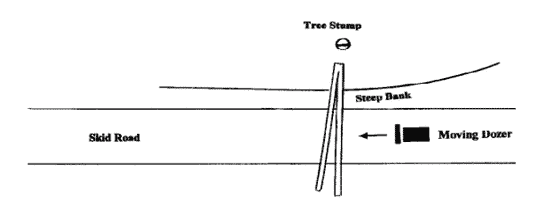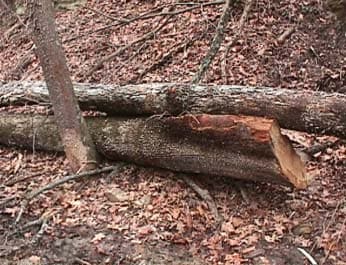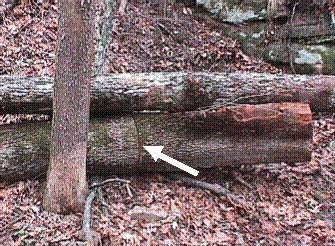Logger in Training Dies After Being Struck by a Previously Felled Tree Which Rolled off of a Bank in West Virginia
Case: 02WV040-01
Release Date: March 19, 2003
SUMMARY
On December 3, 2002, an 18-year-old male logger (the victim) died of injuries sustained when he was struck from behind by the section of a felled tree which rolled off the bank directly above him. He was positioned on the skid road with his back to the bank and was trimming the butt of a white oak which had been felled by a coworker. Just prior to the incident his coworker had felled the forked white oak which was located approximately 30 feet above the skid road on top of a 10 foot bank. Both sections of the forked oak fell across the skid road and remained attached to each other. The victim then topped both tree sections. A dozer operator, needing access to other timber, attempted to push the sections out of the road and off the bank. In doing so, the tree forks separated at the base and one of the two sections fell from the bank and landed parallel to the skid road. The other section remained diagonally upon the bank directly above the first. The dozer continued down the skid road and parked. The owner and victim were walking past the precariously elevated section when the victim decided to trim the butt of the other tree section which was down on the road. With his back to the elevated butt, he began his cut. The owner, realizing what he was doing, turned towards the victim. At that point the elevated log began to slide off the bank. The owner yelled to warn the victim, who not hear his warning, but continued cutting, and was struck from behind. The falling tree pushed the victim down placing his head between the two trees as they contacted one another. Witnessing the incident, the owner responded by telling another worker in the area to run down the hill and summon EMS. The owner noted the massive head trauma, checked for vital signs, but found none. EMS arrived shortly thereafter pronouncing the victim dead at the incident scene.
The WV FACE Investigator concluded that, to reduce the likelihood of similar occurrences, employers should:
- ensure that workers properly evaluate the area around the task to be performed prior to starting so that potential hazards can be identified and avoided.
- ensure that dozer operators perform a post-operation visual inspection of sloped areas adjacent to roads and work areas for the purpose of identifying and abating newly-created hazards such as unstable tree segments.
- develop, implement, and enforce a written safety program which includes, but is not limited to, task-specific safety procedures and worker training in hazard identification, avoidance, and control.
INTRODUCTION
On December 3, 2002, an 18-year-old male logger (the victim) died of injuries sustained when he was struck from behind by a section of a felled tree which rolled off the bank directly above him. On December 4, 2002, the West Virginia FACE Investigator was notified of the death by a newspaper clipping service. The FACE Investigator contacted the West Virginia Division of Forestry (WVDOF). The incident was reviewed with the WVDOF representative, who then accompanied the investigator to the site where an investigation was conducted on December 17, 2002. The victim’s employer, who witnessed the incident, was interviewed as well as the dozer operator who was in the immediate vicinity. The incident site was examined and photographed. Other informational sources and contacts included: death certificate, medical examiner’s report, newspaper articles, WVDOF, and OSHA.
The employer in this incident was a commercial logging company which had been in business for 5 years. The land was privately owned and was being selectively timbered. At the time of the incident, the workforce totaled 5 including the victim and the owner. The company had a designated safety director (owner). Safety meetings were held twice a month. It was reported that new workers were not permitted to work alone and were paired with an experienced worker for ongoing instruction and guidance. There was no written safety program or task-specific work rules.
The operation had a certified logger at the site. Certified Logger status in West Virginia. [Note: The Logging Sediment Control Act of West Virginia (1992) requires that each timbering operation in West Virginia be supervised by a certified logger. To become a certified logger, an individual is required to successfully complete training and pass a test for best management practices (a soil erosion prevention plan) and chain saw safety as well as possess a current first aid card.1]
The victim’s job at the time of the incident was that of topping trees being felled by his mentor. He had little logging experience and some chainsaw experience. He had only been with the company for approximately two weeks when the incident occurred. The victim was wearing a hard-hat, hearing protection, face screen, and chaps. He had just returned from lunch shortly before the incident.
INVESTIGATION
On December 3, 2002, an 18-year-old male logger (the victim) died of injuries sustained when he was struck from behind by the section of a felled tree which rolled off the bank directly above him. He was positioned on the skid road with his back to the bank and was trimming the butt of one of two sections of a forked white oak which had been felled by a coworker. Just prior to the incident, his coworker had felled the forked white oak which was located approximately 30 feet above the skid road on top of a 10 foot bank (see Figure 1). Both sections of the forked oak fell perpendicular across the skid road and remained attached at the butt. The victim then topped both tree sections. A dozer operator, needing access to other timber, attempted to push the sections out of the road and off the bank. In doing so, the tree forks separated at the base as the trees pivoted. One of the two sections fell from the bank and landed parallel to the skid road. The other section remained diagonally upon the bank directly above the first (see Figure 2). The dozer continued down the skid road and parked. The owner and victim were walking past the precariously elevated section of tree when the victim decided to trim the butt of the other tree section which was down on the road. With his back to the elevated butt, he began his cut. The owner, realizing what he was doing, turn towards the victim. At that point the elevated log began to slide off the bank. The owner yelled to warn the victim who did not hear his warning, but continued cutting, and was struck from behind (see Figure 3). The falling tree pushed the victim down placing his head between the two trees as they contacted each other (see Figure 4). Witnessing the incident, the owner responded by telling another worker in the area to run down the hill and summon EMS. The owner noted the massive head trauma, checked for vital signs, but found none. EMS arrived shortly thereafter pronouncing the victim dead at the incident scene.
CAUSE OF DEATH
The medical examiner’s report listed the immediate cause of death as cranial cerebral crush injury.
RECOMMENDATIONS/DISCUSSION
Recommendation # 1: Employers should ensure that workers properly evaluate the area around the task to be performed prior to starting so that potential hazards can be identified and avoided.
Discussion: In this incident the victim, without hesitation, positioned himself directly below an elevated load. The log’s diagonally elevated orientation greatly reduced its potential for stability. Workers need to realize the importance of “working defensively” by taking the time to look things over from a safety perspective. Elevated loads of any type should be avoided at all costs. If the victim had taken a moment to evaluate the task at hand, as well as the work area for associated hazards, he likely would have realized the logs precarious position and deadly potential energy. Pre-task evaluation may have given the victim the chance to decide not to position himself directly below the load.
Recommendation # 2: Employers should ensure that dozer operators perform a post-operation visual inspection of sloped areas adjacent to roads and work areas for the purpose of identifying and abating newly-created hazards such as unstable tree segments.
Discussion: In this incident, the dozer operator created the hazard when he attempted to push the tree segments off of the road. Upon clearing the road, the operator left one tree segment in the unsafe elevated position and continued further down the road to access other work. CFR 1910.266 d(6)(i) requires that employees shall be spaced and the duties of each employee shall be organized so the actions of one employee will not create a hazard for any other employee. 2 Having performed a brief post-operation visual inspection from the operator’s seat, would have revealed the presence of the newly created and precariously positioned hazard. Once identified, this hazard could have been abated by pulling it off of the hillside prior to exposing other workers. This could have been accomplished by attaching the dozer’s cable to the segment’s non-elevated end and pulling it off of the bank At the very least, it should have been flagged and avoided.
Recommendation #3: Employers should develop, implement, and enforce a written safety program which includes, but is not limited to, task-specific safety procedures and worker training in hazard identification, avoidance, and control.
Discussion: The evaluation of tasks to be performed at the work site form the basis for the development, implementation, and enforcement of a safety program as well as task-specific safety procedures. The key elements of the program should include the communication of task-specific safe work practices and, at a minimum, training in hazard identification and the avoidance and abatement of these hazards. In this incident, the victim was fatally injured when he approached an unsafe situation (an unsecured and unmarked elevated load). Training in the hazards associated with the work environment and task-specific safety procedures through a comprehensive safety program may have given the victim the knowledge necessary to recognize and avoid a hazardous situation. CFR 1910.266(i)(3)(iii) requires that workers be trained in the recognition of safety and health hazards that are associated with their assigned job tasks, including the use of measures and work practices to prevent or control these hazards.2
REFERENCES
- West Virginia Logging Sediment Control Act, 1992.
- Office of the Federal Register: Federal Register, Vol. 59, No. 196, 29 CFR 1910.266, 1995.
ILLUSTRATIONS

Figure l. This illustrates the tree’s position as felled and topped.
Note the segments are still attached at the base.
Dozer is about to attempt to push the tree off the bank and road as one unit.

Figure 2. This illustrates the parked dozer, final position of the tree segments,
and the victim’s position under the precariously elevated tree segment.

Figure 3. This photo shows point where the victim was struck.

Figure 4. The arrow points to the chainsaw kerf left by the victim
as he attempted to butt the log. From this perspective, the victim
was standing on the opposite side of the lower log, facing the camera,
and reaching over beginning his cut when he was struck from behind.
FATALITY ASSESSMENT AND CONTROL EVALUATION PROGRAM
The WVU Center for Rural Emergency Medicine, through a contract with the West Virginia Department of Health and Human Resources and Bureau for Public Health, conducts investigations on the causes of work-related fatalities within the state. The goal of this program is to prevent future fatal workplace injuries. West Virginia FACE intends to achieve this goal by identifying and studying the risk factors that contribute to workplace fatalities, by recommending intervention strategies, and by disseminating prevention information to employers, employees, trade associations, unions, equipment manufacturers, students, teachers, and others with an interest in workplace safety.
Please use information listed on the Contact Sheet on the NIOSH FACE website to contact In-house FACE program personnel regarding In-house FACE reports and to gain assistance when State-FACE program personnel cannot be reached.
